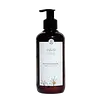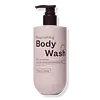What's inside
What's inside
 Key Ingredients
Key Ingredients

 Benefits
Benefits

 Concerns
Concerns

 Ingredients Side-by-side
Ingredients Side-by-side

Water
Skin ConditioningDecyl Glucoside
CleansingSodium Lauroyl Lactylate
EmulsifyingSodium Lauroyl Sarcosinate
CleansingCoco-Glucoside
CleansingGlycerin
HumectantGlyceryl Stearate
EmollientSclerotium Gum
Emulsion StabilisingLactic Acid
BufferingHippophae Rhamnoides Oil
EmollientCocos Nucifera Oil
MaskingSodium Levulinate
Skin ConditioningSodium Anisate
AntimicrobialSqualane
EmollientEucalyptus Globulus Oil
Rosmarinus Officinalis Leaf Oil
MaskingMentha Piperita Oil
MaskingRosmarinus Officinalis Leaf
Skin ConditioningWater, Decyl Glucoside, Sodium Lauroyl Lactylate, Sodium Lauroyl Sarcosinate, Coco-Glucoside, Glycerin, Glyceryl Stearate, Sclerotium Gum, Lactic Acid, Hippophae Rhamnoides Oil, Cocos Nucifera Oil, Sodium Levulinate, Sodium Anisate, Squalane, Eucalyptus Globulus Oil, Rosmarinus Officinalis Leaf Oil, Mentha Piperita Oil, Rosmarinus Officinalis Leaf
Water
Skin ConditioningCocamidopropyl Betaine
CleansingSodium Lauroyl Sarcosinate
CleansingGlycol Distearate
EmollientLaureth-4
EmulsifyingDecyl Glucoside
CleansingCocamine Oxide
CleansingAcrylates/C10-30 Alkyl Acrylate Crosspolymer
Emulsion StabilisingParfum
MaskingPotassium Sorbate
PreservativeAvena Sativa Straw Extract
Skin ConditioningPanthenol
Skin ConditioningTocopheryl Acetate
AntioxidantSqualane
EmollientPersea Gratissima Oil
Skin ConditioningPhenoxyethanol
PreservativeTriethanolamine
BufferingWater, Cocamidopropyl Betaine, Sodium Lauroyl Sarcosinate, Glycol Distearate, Laureth-4, Decyl Glucoside, Cocamine Oxide, Acrylates/C10-30 Alkyl Acrylate Crosspolymer, Parfum, Potassium Sorbate, Avena Sativa Straw Extract, Panthenol, Tocopheryl Acetate, Squalane, Persea Gratissima Oil, Phenoxyethanol, Triethanolamine
Ingredients Explained
These ingredients are found in both products.
Ingredients higher up in an ingredient list are typically present in a larger amount.
Decyl Glucoside is a glucose-based surfactant and emulsion stabilizer. It is created by reacting glucose with the fatty acids from plants.
Surfactants help clean the skin by trapping oil, sebum, and dirt to be washed away. As an emulsion stabilizer, it stabilizes the ingredients in a product by preventing them from separating.
This ingredient is biodegradable and non-toxic. This ingredient is commonly found in baby shampoos.
Decyl Glucoside is sometimes used to stabilize the UV filter Tinosorb.
Learn more about Decyl GlucosideSodium Lauroyl Sarcosinate is a cleansing agent and emulsifier. It is a surfactant derived from sarcosine, and a common source is coconut oil.
As a surfactant, Sodium Lauroyl Sarcosinate helps lift dirts, oil, and other molecules to be washed away. In leave-on products, this ingredient is used as an emulsifier. Emulsifier help prevent ingredients such as oils and waters from separating.
Sodium Lauroyl Sarcosinate is also commonly found as a foaming agent in shampoo, toothpaste, and shaving foam. It is amphiphilic, meaning it loves both water and fats.
Learn more about Sodium Lauroyl SarcosinateSqualane is an emollient that helps the skin hold onto moisture. It's an oily liquid that occurs naturally in certain types of fish and plant oils.
Because squalane boosts hydration in the skin, it also comes with plenty of benefits: it is an antioxidant and can help fight free radicals and skin damage. Squalane is also found to have a detoxifying effect when applied.
Squalane comes from squalene, which occurs naturally within the sebum of our skin. It is one of the oils our skin produces to keep itself hydrated. Squalane is the hydrogenated version of squalene and has a longer shelf life.
Research shows that squalane is non-irritating (even at 100% concentration).
In general, it's a fantastic ingredient. It does a great job at hydrating the skin, and it's suitable for those with sensitive skin.
The source of squalane may impact malassezia / fungal acne. This is because olive oil derived squalane can contain impurities such as fatty acids and plant waxes. Sugarcane derived squalane is recommended for anyone with malassezia concerns.
Is squalane vegan?
This depends on the source. Squalane can be derived from both plants and animals. Most squalane used in skincare comes from plants.
Please note: the source of squalane is only known if disclosed by the brand. We recommend reaching out to the brand if you have any questions about their squalane.
Read more about squalene with an "e".
Is squalane an oil?
Squalane is often called an oil, but it’s technically not; it’s a hydrocarbon, meaning it’s only made of carbon and hydrogen, unlike true oils which are triglycerides made of fatty acids and glycerol.
The term “oil-free” isn’t regulated, so companies can define it however they want. Some exclude all oils, while others just avoid mineral oil or comedogenic oils.
While some people avoid oils thinking they cause breakouts, the right kind of oil (or oil-like ingredient like squalane) can actually help balance and hydrate your skin. It’s worth testing out simple oils or squalane to see what works best for your skin.
Learn more about SqualaneWater. It's the most common cosmetic ingredient of all. You'll usually see it at the top of ingredient lists, meaning that it makes up the largest part of the product.
So why is it so popular? Water most often acts as a solvent - this means that it helps dissolve other ingredients into the formulation.
You'll also recognize water as that liquid we all need to stay alive. If you see this, drink a glass of water. Stay hydrated!
Learn more about Water